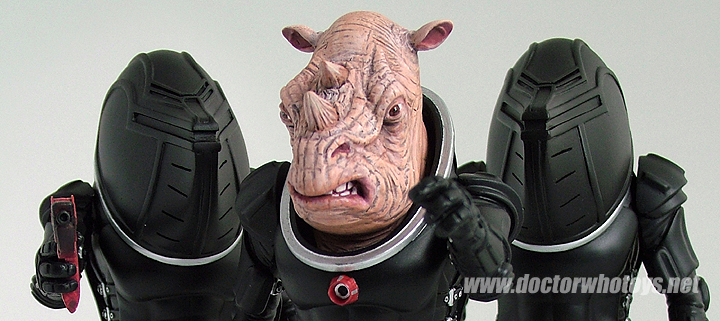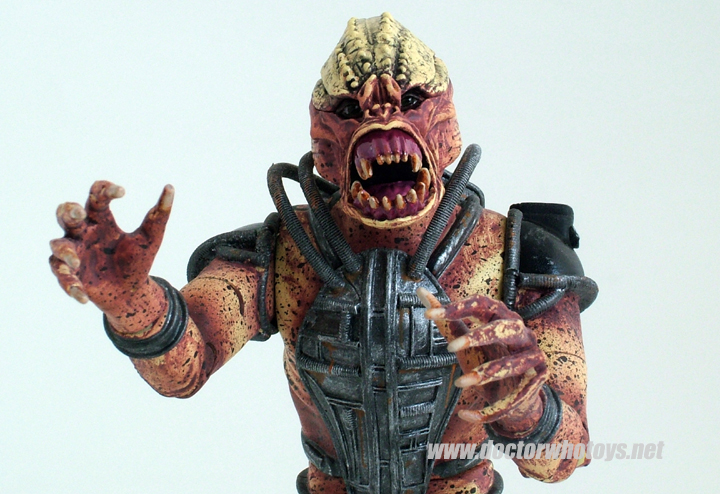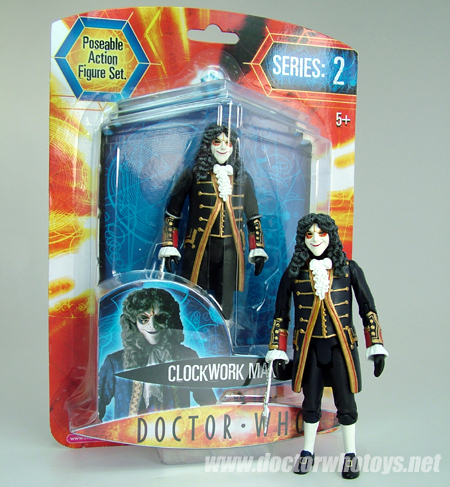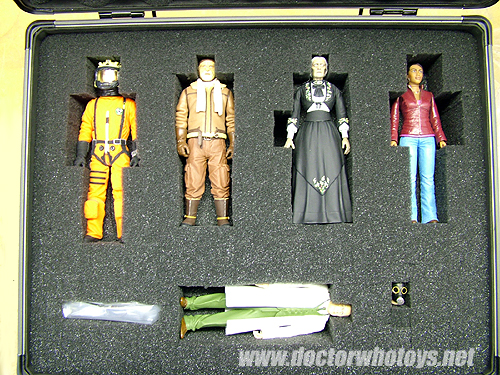doctorwhotoys.net







Exclusive Interview with Edmund Barnett-Ward, Director of Sculpting at Designworks Windsor, the company that sculpts Character Options
Doctor Who Action Figures
This interview took place in Windsor, England on the 27th February 2008 and is Strictly
Copyright © doctorwhotoys.net, All Rights Reserved; may not be reproduced in full or part.
All images are for the exclusive use of doctorwhotoys.net approved by and copyright © Designworks Windsor, Character Group plc and the BBC

Part 1 Behind the Scenes at Designworks
Part 2 All About Ed
Part 3 A Little History
Part 4 The Making of Doctor Who Action Figures
Part 5 Traditional Sculpting
Part 6 Sculpting Materials
Part 7 Approval
Part 8 Digital Sculpting
Part 9 The Sculptors
Part 10 The Story So Far
Welcome to Part 7 of a multi-part 10,000 word series describing in detail the making of Doctor Who Action Figures and including 63 exclusive new images of the figures in various stages of production.
"Often Alisdair [Dewar, Head of Research & Development at Character Options] will see the work as a 'grey'; he'll come in for a meeting and I'll take everything from the workshop that's at that level of progress for him to look at. Sometimes he'll pass a comment and we'll do a little tweak at that stage based on something he's noticed. Ultimately he's the client so always we'll gear towards making sure that he's happy with each of the sculpts that we do. Once a sculpt has been approved, meaning I'm happy with it, Al's happy with it and the sculptor is happy with it, and baked off for the correct time, the next step is molding it."

Judoon Approval Decos - All images exclusively approved for use only on doctorwhotoys.net by Designworks, Character Options and the BBC.
"The figures are always molded before approval at the BBC. We will create a silicon mould of each of the items. We have a Casting Department which takes all the constituent parts of the figure. In the case of Constantine, two hands, two arms, the legs and hips are generally done as one piece with the feet attached, the torso, any over-moulded jacket and a head and the accessories. A silicon mould is made of each one of them so that an exact duplicate of this model can be produced in resin. That model will be produced in coloured resin. The resins come in two parts, in liquid form."
"We have an automated casting machine here. We slot the mould in the bottom and connect a pipe to it which is connected to a funnel. Inside the machine there are two beakers containing part A and part B of the material. One of the beakers also contains a pigment that dyes the plastic. The two beakers are mixed together and then poured into the mould under vacuum so that all air is sucked out to avoid air bubbles in the castings. The moulds are filled up and 45 minutes later the plastic is cured and you get a 'looks like' sample. In the case of Doctor Constantine, his coat is white so we'd cast it out in a white material. We'd probably do the legs and feet in green because his trousers are green. His head would be in a flesh colour. Then he'll be painted, decorated up and sent in for BBC approval."
"We have a different team of people who create all the decorated samples for approval. What we tend to do is present people with a product that they are familiar with from how it appears on screen. The majority of reference photographs we get are taken in a white studio which doesn't represent what they look like on screen."

Hoix Approval Deco - All images exclusively approved for use only on doctorwhotoys.net by Designworks, Character Options and the BBC.
"So if you look at something like the Hoix it only appeared a little bit at the start of one of the programmes but it was in very atmospheric lighting so we are not necessarily going to decorate, to paint it, in the same way that it looks when you photograph it in natural daylight. We want to do it so that it looks its best, so we'll do it how it appeared on screen. Thats a decision that we've arrived at with the BBC after realising with certain things that we've done in the past, like the Clockwork Man for instance, when it was realised that the coat was actually a very dark blue rather than black, that changes had to be made at a later date."

Black Clockwork Man (in pack) and revised Dark Blue Clockwork Man (posed) - All images exclusively approved for use only on doctorwhotoys.net by Designworks, Character Options and the BBC.
"Lets say I have a head for instance and I want to make a mould of it; I get a flat piece of perspex and I line it up with a primary feed at one point and then what we call 'breathers' off other points. You look for parts of a model that might trap air and always on heads they are molded at an angle with a stick coming off each ear because ears can trap air. Then you put a box around it and pour liquid silicon in. The silicon sets and completely encapsulates the object. When cured, you rip the box off and then cut into the silicon, pull the object out and you are left with the cavity, the mould which is two halves. This is done by the Casting Department."
"In the case of the Reaper figure, for example, we did the electronics in it for the light effects and the material its cast out in is a translucent resin so the whole figure is a see through orange but we will paint it so that only the portion in the chest that we want to retain that translucency is visible."
"The figure we produce is as close to the end look as we can get. We're saying to the BBC when we submit this item 'this is what the finished product will look like'. Thats always the aim; to present them with something that is as close to the finished product as possible."
"At the BBC there is a special department that entirely deals with the Doctor Who licence. In addition, the model, depending on who needs to be involved with seeing it, will be seen by the costume department, the art department, the actor and of course BBC Worlwide. So anything up to four people will look at the model and provide comments. Those comments come back to us and we might amend the model, or we might not need to, depending on the individual case."
"If we have to do any amendments , we will do the amendments, and it will be remolded and then recast, redecorated and resubmitted. If its just decoration, which happens plenty of times, - the sculpts approved first off but the costume department say something like 'I know those jeans look black but actually they are dark blue and heres a picture for additional reference' - then we'll just redecorate the first sample and send it back in for approval."

Figures Going for Approval - All images exclusively approved for use only on doctorwhotoys.net by Designworks, Character Options and the BBC.
"Once its received approval we do a second decorated sample and we send that off to the Far East. That decorated sample is sent off with a master to the Far East. The decorated sample is identical, as far as possible, to the one that we submitted for approval. The master is a grey resin, a blank resin version of the original sculpture. We never send the original sculpture, we always retain that in case we need to do anything further down the line, for example if they need any more replications or for whatever reason. We always retain the original sculpture provided it survives molding, and some of them don't because some of them are extremely delicate - like I don't think the Reaper survived for example."
"In the Far East the model will be broken up for articulation and the final tooling pattern will be created for the figure. The model will be given a level of articulation that we didn't put in to the original sculpt. The tooling pattern is the model that's used to make the metal moulds which produce the final plastic toys. So the tooling pattern is the last stage at which it's a model and that's the bit Designworks has nothing to do with, but Alisdair has everything to do with."
"That again is a part of the success of the Doctor Who toys - that Alisdair is very careful about his tooling patterns to make sure that they accurately and faithfully represent what we gave the Far East. A lot of times, you will find a lot of other companies, they might present at Toy Fair a beautiful looking prototype which ends up looking nothing like the final toy and that's probably because whoever was in charge of that project just sent off the prototype and didn't deal with it again until it came back as a product. Al never does that."
"The models will always lose something, but at the end of the day thats part of it being a plastic toy. You have to use a process which allows them to be mass produced and that inevitably involves losing a degree of detail."
Thanks Ed
Now Read Part 8: Digital Sculpting
Don't miss Part 8 in which Ed talks exclusively to doctorwhotoys.net about digital sculpting. Part 8 includes amazing images of digitally sculpted Doctor Who figures.
Part 1 Behind the Scenes at Designworks
Part 2 All About Ed
Part 3 A Little History
Part 4 The Making of Doctor Who Action Figures
Part 5 Traditional Sculpting
Part 6 Sculpting Materials
Part 7 Approval
Part 8 Digital Sculpting
Part 9 The Sculptors
Part 10 The Story So Far
This interview is Strictly Copyright © doctorwhotoys.net, All Rights Reserved; may not be reproduced in full or part. All images are for the exclusive use of doctorwhotoys.net approved by and copyright © Designworks Windsor, Character Group plc and the BBC
List Portraits 12" Gallery News Contact
Content is copyright © doctorwhotoys.net